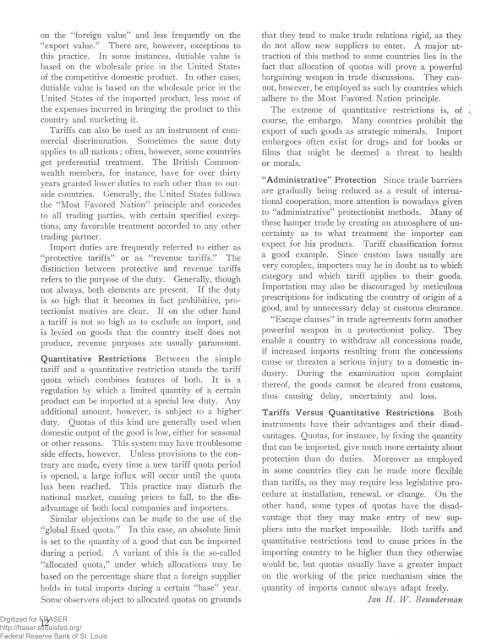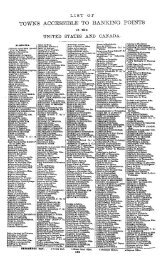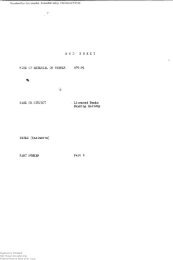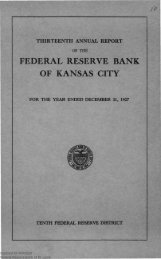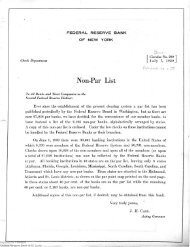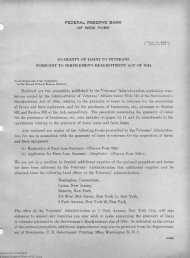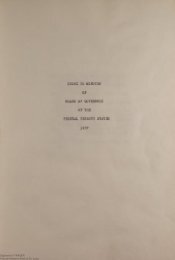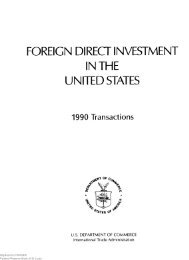Download File (6.3M) - Fraser - Federal Reserve Bank of St. Louis
Download File (6.3M) - Fraser - Federal Reserve Bank of St. Louis
Download File (6.3M) - Fraser - Federal Reserve Bank of St. Louis
You also want an ePaper? Increase the reach of your titles
YUMPU automatically turns print PDFs into web optimized ePapers that Google loves.
12<br />
Digitized for FRASER<br />
http://fraser.stlouisfed.org/<br />
<strong>Federal</strong> <strong>Reserve</strong> <strong>Bank</strong> <strong>of</strong> <strong>St</strong>. <strong>Louis</strong><br />
on the “ foreign value” and less frequently on the<br />
“ export value.” There are, however, exceptions to<br />
this practice. In some instances, dutiable value is<br />
based on the wholesale price in the United <strong>St</strong>ates<br />
<strong>of</strong> the competitive domestic product. In other cases,<br />
dutiable value is based on the wholesale price in the<br />
United <strong>St</strong>ates <strong>of</strong> the imported product, less most <strong>of</strong><br />
the expenses incurred in bringing the product to this<br />
country and marketing it.<br />
Tariffs can also be used as an instrument <strong>of</strong> commercial<br />
discrimination. Sometimes the same duty<br />
applies to all nations; <strong>of</strong>ten, however, some countries<br />
get preferential treatment. The British Commonwealth<br />
members, for instance, have for over thirty<br />
years granted lower duties to each other than to outside<br />
countries. Generally, the United <strong>St</strong>ates follows<br />
the “ Most Favored Nation” principle and concedes<br />
to all trading parties, with certain specified exceptions,<br />
any favorable treatment accorded to any other<br />
trading partner.<br />
Import duties are frequently referred to either as<br />
“ protective tariffs” or as “ revenue tariffs.” The<br />
distinction between protective and revenue tariffs<br />
refers to the purpose <strong>of</strong> the duty. Generally, though<br />
not always, both elements are present. If the duty<br />
is so high that it becomes in fact prohibitive, protectionist<br />
motives are clear. If on the other hand<br />
a tariff is not so high as to exclude an import, and<br />
is levied on goods that the country itself does not<br />
produce, revenue purposes are usually paramount.<br />
Quantitative Restrictions Between the simple<br />
tariff and a quantitative restriction stands the tariff<br />
quota which combines features <strong>of</strong> both. It is a<br />
regulation by which a limited quantity <strong>of</strong> a certain<br />
product can be imported at a special low duty. Any<br />
additional amount, however, is subject to a higher<br />
duty. Quotas <strong>of</strong> this kind are generally used when<br />
domestic output <strong>of</strong> the good is low, either for seasonal<br />
or other reasons. This system may have troublesome<br />
side effects, however. Unless provisions to the contrary<br />
are made, every time a new tariff quota period<br />
is opened, a large influx will occur until the quota<br />
has been reached. This practice may disturb the<br />
national market, causing prices to fall, to the disadvantage<br />
<strong>of</strong> both local companies and importers.<br />
Similar objections can be made to the use <strong>of</strong> the<br />
“ global fixed quota.” In this case, an absolute limit<br />
is set to the quantity <strong>of</strong> a good that can be imported<br />
during a period.<br />
A variant <strong>of</strong> this is the so-called<br />
“ allocated quota,” under which allocations may be<br />
based on the percentage share that a foreign supplier<br />
holds in total imports during a certain “ base” year.<br />
Some observers object to allocated quotas on grounds<br />
that they tend to make trade relations rigid, as they<br />
do not allow new suppliers to enter. A major attraction<br />
<strong>of</strong> this method to some countries lies in the<br />
fact that allocation <strong>of</strong> quotas will prove a powerfulbargaining<br />
weapon in trade discussions. They cannot,<br />
however, be employed as such by countries which<br />
adhere to the Most Fa-yo'red Nation principle.<br />
The extreme <strong>of</strong> quantitative restrictions is, <strong>of</strong> v<br />
course, the embargo. Many countries prohibit the<br />
export <strong>of</strong> such goods as strategic minerals. Import<br />
embargoes <strong>of</strong>ten exist for drugs and for books or<br />
films that might be deemed a threat to health<br />
or morals.<br />
“Administrative” Protection Since trade barriers<br />
are gradually being reduced as a result <strong>of</strong> international<br />
cooperation, more attention is nowadays given<br />
to “ administrative” protectionist methods. Many <strong>of</strong><br />
these hamper trade by creating an atmosphere <strong>of</strong> uncertainty<br />
as to what treatment the importer can<br />
expect for his products. Tariff classification forms<br />
a good example. Since custom laws usually are<br />
very complex, importers may be in doubt as to which<br />
category and which tariff applies to their goods.<br />
Importation may also be discouraged by meticulous<br />
prescriptions for indicating the country <strong>of</strong> origin <strong>of</strong> a<br />
good, and by unnecessary delay at customs clearance.<br />
“ Escape clauses” in trade agreements form another<br />
powerful weapon in a protectionist policy. They<br />
enable a country to withdraw all concessions made,<br />
if increased imports resulting from the concessions<br />
cause or threaten a serious injury to a domestic industry.<br />
During the examination upon complaint<br />
there<strong>of</strong>, the goods cannot be cleared from customs,<br />
thus causing delay, uncertainty and loss.<br />
Tariffs Versus Quantitative Restrictions<br />
Both<br />
instruments have their advantages and their disadvantages.<br />
Quotas, for instance, by fixing the quantity<br />
that can be imported, give much more certainty about<br />
protection than do duties.<br />
Moreover as employed<br />
in some countries they can be made more flexible<br />
than tariffs, as they may require less legislative procedure<br />
at installation, renewal, or change.<br />
On the<br />
other hand, some types <strong>of</strong> quotas have the disadvantage<br />
that they may make entry <strong>of</strong> new suppliers<br />
into the market impossible.<br />
Both tariffs and<br />
quantitative restrictions tend to cause prices in the<br />
importing country to be higher than they otherwise<br />
would be, but quotas usually have a greater impact<br />
on the working <strong>of</strong> the price mechanism since the<br />
quantity <strong>of</strong> imports cannot always adapt freely.<br />
Jan H. W . Beunderman


